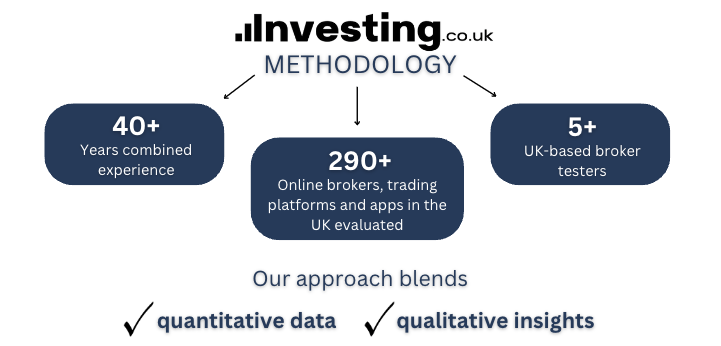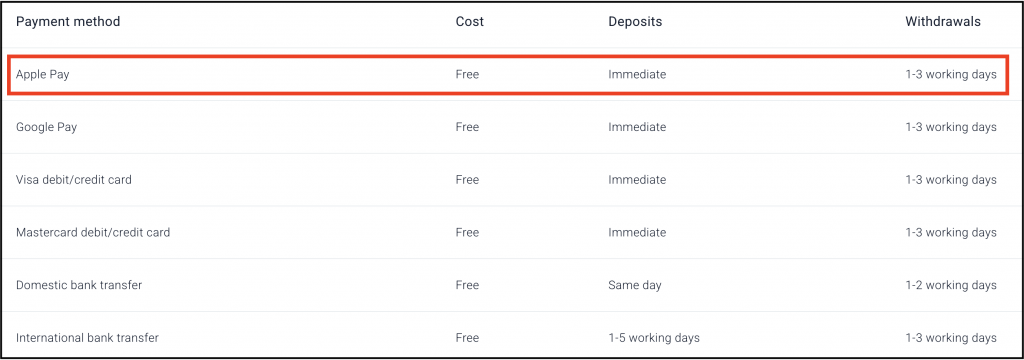Best Apple Pay Brokers 2025
Apple Pay is widely used in the UK—in shops, online, and now with trading accounts. For many traders, it’s the easiest way to add funds, but brokers don’t all handle it the same. Some limit deposits, others block withdrawals, and a few don’t support it at all.
We reveal the best UK brokers that accept Apple Pay deposits and what details to check first.
Top Apple Pay Brokers
-
Founded in Australia in 2010, Pepperstone is a highly regarded broker specialising in forex and CFDs. Serving more than 400,000 clients globally, it provides access to over 1,300 financial instruments through popular platforms like MT4, MT5, cTrader, and TradingView. Its fee structure is both low and transparent. With regulation by reputable bodies such as the FCA, ASIC, and CySEC, Pepperstone guarantees a safe trading environment for traders at every level.
Instruments Regulator Platforms CFDs, Forex, Currency Indices, Stocks, Indices, Commodities, ETFs, Crypto (only Pro clients), Spread Betting FCA, ASIC, CySEC, DFSA, CMA, BaFin, SCB MT4, MT5, cTrader, TradingView, AutoChartist, DupliTrade, Quantower Min. Deposit Min. Trade Leverage $0 0.01 Lots 1:30 (Retail), 1:500 (Pro) -
Founded in 2008 and based in Israel, Plus500 is a leading brokerage with over 25 million registered traders across more than 50 countries. It focuses on CFD trading, offering a user-friendly proprietary platform and mobile app. The company provides competitive spreads and does not impose commissions or charges for deposits or withdrawals. Plus500 stands out as a highly trusted broker, licensed by respected authorities such as the FCA, ASIC, and CySEC.
Instruments Regulator Platforms CFDs on Forex, Stocks, Indices, Commodities, ETFs, Options FCA, ASIC, CySEC, DFSA, MAS, FSA, FSCA, FMA, EFSA WebTrader, App Min. Deposit Min. Trade Leverage $100 Variable Yes -
Established in 2015, VT Markets is a leading Australian multi-asset CFD broker. Offering over 1,000 trading instruments, it supports both MetaTrader 4 and MetaTrader 5 platforms. With these resources, VT Markets provides extensive trading opportunities to more than 400,000 clients globally. It operates under the regulation of ASIC, FSCA, and FSC.
Instruments Regulator Platforms CFDs, Forex, Commodities, Stocks, Indices ASIC, FSCA, FSC VT Markets App, Webtrader, Web Trader+, MT4, MT5, TradingCentral Min. Deposit Min. Trade Leverage 50 - 500 USD 0.01 Lots 1:500 -
Founded in 2017, Pocket Option is a binary options broker providing high/low contracts for forex, stocks, indices, commodities, and cryptocurrencies. Attracting more than 100,000 active users worldwide, the platform remains a favourite among emerging traders.
Instruments Regulator Platforms Binary Options, Currencies, Commodities, Stocks, Indices, Cryptos Web, MT4, MT5 Min. Deposit Min. Trade Leverage $5 $1 -
IQCent, an offshore brokerage in the Marshall Islands, specialises in binary options and CFDs. The firm provides distinct account options offering bonuses, benefits, payout increases, TradeBacks, and complimentary rollovers. With over 175 assets, 24/7 trading, and 98% payouts, it attracts budding traders.
Instruments Regulator Platforms Binary Options, CFDs, Forex, Indices, Commodities, Crypto Online Platform, TradingView Min. Deposit Min. Trade Leverage $250 $0.01 1:500 -
FXCM, a reputable forex and CFD broker founded in 1999, is headquartered in the UK. It has garnered multiple accolades and operates in several regions, including the UK and Australia. Offering more than 400 assets and comprehensive analysis tools without any commission charges, FXCM is a favoured option among traders. The broker is also under the regulation of leading bodies such as the FCA, ASIC, CySEC, FSCA, and BaFin.
Instruments Regulator Platforms Forex, Stock CFDs, Commodities CFDs, Crypto CFDs FCA, CySEC, ASIC, FSCA, BaFin, CIRO Trading Station, MT4, TradingView, Quantower Min. Deposit Min. Trade Leverage $50 Variable 1:400 -
Founded in 2017, OKX is a reputable cryptocurrency company, providing a comprehensive range of offerings, including trading and NFTs. It enables traders to access more than 400 crypto tokens through OTC trading and derivatives. Its excellent web platform, developer tools, and interactive charts make OKX a preferred option among technical traders.
Instruments Regulator Platforms Spot, futures, perpetual swaps, options VARA AlgoTrader, Quantower Min. Deposit Min. Trade Leverage 10 USDT Variable
Safety Comparison
Compare how safe the Best Apple Pay Brokers 2025 are and what features they offer to protect traders.
| Broker | Trust Rating | FCA Regulated | Negative Balance Protection | Guaranteed Stop Loss | Segregated Accounts |
|---|---|---|---|---|---|
| Pepperstone | ✔ | ✔ | ✘ | ✔ | |
| Plus500 | ✔ | ✔ | ✔ | ✔ | |
| VT Markets | ✘ | ✔ | ✘ | ✔ | |
| Pocket Option | ✘ | ✘ | ✘ | ✘ | |
| IQCent | ✘ | ✘ | ✘ | ✘ | |
| FXCM | ✔ | ✔ | ✘ | ✔ | |
| OKX | ✘ | ✘ | ✘ | ✘ |
Payments Comparison
Compare which popular payment methods the Best Apple Pay Brokers 2025 support and whether they have trading accounts denominated in British Pounds (GBP).
| Broker | GBP Account | Debit Card | Credit Card | Neteller | Skrill | Apple Pay |
|---|---|---|---|---|---|---|
| Pepperstone | ✔ | ✔ | ✔ | ✔ | ✔ | ✔ |
| Plus500 | ✔ | ✔ | ✔ | ✘ | ✔ | ✔ |
| VT Markets | ✔ | ✔ | ✔ | ✔ | ✔ | ✔ |
| Pocket Option | ✘ | ✔ | ✔ | ✘ | ✘ | ✔ |
| IQCent | ✘ | ✔ | ✔ | ✘ | ✘ | ✔ |
| FXCM | ✔ | ✔ | ✔ | ✘ | ✘ | ✔ |
| OKX | ✔ | ✘ | ✔ | ✘ | ✘ | ✔ |
Mobile Trading Comparison
How good are the Best Apple Pay Brokers 2025 at mobile trading using apps or other mobile interfaces.
| Broker | Mobile Apps | iOS Rating | Android Rating | Smart Watch App |
|---|---|---|---|---|
| Pepperstone | iOS & Android | ✘ | ||
| Plus500 | iOS, Android & Windows | ✘ | ||
| VT Markets | iOS & Android | ✘ | ||
| Pocket Option | iOS & Android | ✘ | ||
| IQCent | iOS & Android | ✘ | ||
| FXCM | iOS and Android | ✘ | ||
| OKX | Android & iOS | ✘ |
Beginners Comparison
Are the Best Apple Pay Brokers 2025 good for beginner traders, that might want an affordable setup to get started, along with good support and educational resources?
| Broker | Demo Account | Minimum Deposit | Minimum Trade | Support Rating | Education Rating |
|---|---|---|---|---|---|
| Pepperstone | ✔ | $0 | 0.01 Lots | ||
| Plus500 | ✔ | $100 | Variable | ||
| VT Markets | ✔ | 50 - 500 USD | 0.01 Lots | ||
| Pocket Option | ✔ | $5 | $1 | ||
| IQCent | ✔ | $250 | $0.01 | ||
| FXCM | ✔ | $50 | Variable | ||
| OKX | ✔ | 10 USDT | Variable |
Advanced Trading Comparison
Do the Best Apple Pay Brokers 2025 offer features that allow for more advanced trading strategies?
| Broker | Automated Trading | Pro Account | Leverage | VPS | AI | Low Latency | Extended Hours |
|---|---|---|---|---|---|---|---|
| Pepperstone | Expert Advisors (EAs) on MetaTrader | ✔ | 1:30 (Retail), 1:500 (Pro) | ✔ | ✘ | ✔ | ✘ |
| Plus500 | ✘ | ✘ | ✔ | ✘ | ✔ | ✘ | ✘ |
| VT Markets | Expert Advisors (EAs) on MetaTrader | ✘ | 1:500 | ✘ | ✘ | ✘ | ✘ |
| Pocket Option | ✔ | ✘ | - | ✘ | ✔ | ✘ | ✘ |
| IQCent | ✔ | ✘ | 1:500 | ✘ | ✔ | ✘ | ✘ |
| FXCM | - | ✘ | 1:400 | ✘ | ✔ | ✘ | ✘ |
| OKX | ✔ | ✘ | - | ✘ | ✘ | ✘ | ✘ |
Detailed Rating Comparison
Use this heatmap to compare our detailed ratings for all of the Best Apple Pay Brokers 2025.
| Broker | Trust | Platforms | Mobile | Assets | Fees | Accounts | Support | Research | Education |
|---|---|---|---|---|---|---|---|---|---|
| Pepperstone | |||||||||
| Plus500 | |||||||||
| VT Markets | |||||||||
| Pocket Option | |||||||||
| IQCent | |||||||||
| FXCM | |||||||||
| OKX |
Our Take On Pepperstone
"Pepperstone is a premier trading platform, providing tight spreads, swift execution, and sophisticated charting tools for seasoned traders. Beginners benefit from no minimum deposit, comprehensive learning materials, and outstanding 24/7 support."
Pros
- Pepperstone offers rapid execution speeds of approximately 30ms, enabling swift order processing and execution, making it ideal for traders.
- The award-winning customer support can be accessed through phone, email, or live chat. During tests, response times have consistently been under 5 minutes.
- Over the years, Pepperstone has consistently garnered recognition from DayTrading.com’s annual awards. Recently, it was honoured as the 'Best Overall Broker' in 2025 and was the 'Best Forex Broker' runner-up the same year.
Cons
- Although its market range has improved, its crypto offerings remain limited compared to brokers specialising in this sector, lacking real coin investment options.
- Pepperstone's demo accounts expire after 30 days, which may not provide sufficient time to explore various platforms and evaluate trading strategies.
- Pepperstone doesn't offer cTrader Copy, a favoured feature for copying trades found in the cTrader platform, which is available on other platforms such as IC Markets. However, Pepperstone has launched its own user-friendly copy trading app.
Our Take On Plus500
"Plus500 provides a seamless experience for traders with its CFD platform, featuring a sleek design and interactive charting. However, its research tools are basic, fees are higher than the most economical brokers, and its educational resources could be improved."
Pros
- Plus500 offers a dedicated WebTrader platform tailored specifically for CFD trading. It features a user-friendly and streamlined interface.
- In 2025, Plus500 expanded its range of share CFDs to include emerging sectors such as quantum computing and AI. This update opened up trading opportunities in stocks like IonQ, Rigetti, Duolingo, and Carvana.
- Plus500 has expanded its range of short-term trading instruments by adding VIX options, which feature increased volatility. Additionally, it has extended trading hours for seven stock CFDs.
Cons
- Compared to competitors like IG, Plus500 offers limited research and analysis tools.
- Algorithmic trading and scalping are not available, potentially deterring certain traders.
- The lack of social trading features prevents users from copying trades made by seasoned traders.
Our Take On VT Markets
"VT Markets is an excellent option for traders seeking tight spreads and robust charting tools. The broker excels in share CFDs, offering hundreds of commission-free assets across various global markets."
Pros
- VT Markets provides complimentary 90-day demo accounts, enabling traders to rigorously assess their short-term strategies.
- The top-tier MetaTrader 4 and 5 platforms are available, providing sophisticated charting tools and access to Expert Advisors (EAs).
- Spreads are highly competitive, tested at 0.2 pips for EUR/USD in the ECN account, comparable to leading firms such as Pepperstone.
Cons
- The broker's bonus programmes have strict conditions, including limits on minimum deposits and acceptable payment methods.
- Unlike peers such as Fusion Markets, VT Markets lacks cryptocurrency trading options.
Our Take On Pocket Option
"Pocket Option is a top choice for active traders due to its extensive binary assets and regular platform enhancements, such as 'AI Trading' and expanded expiry options from 3 seconds to 1 month."
Pros
- Traders with a deposit of over $1,000 may receive a 2% or higher payout increase, access to more assets, and enjoy exclusive benefits.
- The MetaTrader platforms provide robust analysis and technical summaries tailored for short-term traders.
- Pocket Option has launched an 'AI Trading' feature that evaluates signals, technical indicators, and trader insights to identify the best trade direction and expiry. Due to limited transparency, test cautiously with minimal stakes.
Cons
- Pocket Option presents a streamlined version of MT4 and MT5, lacking the comprehensive charting tools that experienced traders seek.
- To gain access to over 250 assets, a deposit of $1000 is required. Without this deposit, traders will only have access to a selection of 130 assets.
- Although binary brokers such as IQCent provide returns reaching 98% based on evaluations, others typically offer competitive payouts up to 92%.
Our Take On IQCent
"IQCent caters to traders seeking customised binary assets, offering over 150 products, such as ‘Hype Pool’ contracts for trending events. It features short-term expiries starting at 5 seconds and payouts reaching 95%, with a potential 3% boost. The TradingView charting package, complete with over 100 indicators, suits serious, quick-paced traders."
Pros
- IQCent has expanded its offerings by adding over 60 new assets. This includes popular cryptocurrencies like TON and SHIB, high-ranking stock CFDs such as TSLA and NVDA, and unique FX pairs like THB and HUF.
- CFD trading fees are competitive, with major forex pairs like EUR/USD incurring costs from just 0.7 pips.
- Enthusiastic traders may participate in competitions that offer cash prizes.
Cons
- IQCent lags behind binary brokers such as Quotex due to its limited investment range of approximately 175 assets, including few stocks.
- The broker operates without oversight from a reputable regulator, which is typical for binary options companies.
- The market analysis provides only fundamental details, offering limited technical summaries and insights from analysts.
Our Take On FXCM
"FXCM remains a leading choice for traders using automated strategies, offering four robust platforms, strategy backtesting, and algorithmic trading via APIs. It is also ideal for active traders, providing discounted spreads and minimal to zero commissions on popular assets."
Pros
- The proprietary Trading Station platform is an excellent option for traders seeking a comprehensive tool for their short-term and automated strategies.
- FXCM has broadened its trading options by offering stock CFDs via MetaTrader 4.
- FXCM boasts a strong international reputation, holding licences from the FCA, ASIC, CySEC, and FSCA. With two decades of experience, it commands respect in the trading industry.
Cons
- There are no retail account options available for traders, and Cent/Micro account alternatives are also absent.
- The live chat support is often sluggish and inconsistent when compared to leading competitors.
- While FXCM primarily caters to seasoned traders, the absence of managed accounts is unfortunate.
Our Take On OKX
"OKX is ideal for traders seeking new crypto projects and emerging coins. They can utilise the platform's copy trading feature and automated bots."
Pros
- OKX enjoys a strong reputation, serving 20 million clients worldwide and holding a licence from the Dubai Virtual Assets Regulatory Authority.
- The platform offers an extensive developer lab and access to a marketplace of pre-built trading bots equipped with automatic arbitrage functionalities.
- Active traders benefit from competitive rates, with maker fees starting at 0.02% and taker fees at 0.05%.
Cons
- Testing revealed that customer support quality varied.
- The firm has minimal regulatory oversight, which is typical for crypto brokers.
- The broker's platform and features might feel intricate for beginners.
How Investing.co.uk Chose The Best Brokers That Use Apple Pay
We tested brokers that support Apple Pay, focusing on how easy deposits were to set up, speed of processing, transaction fees, and overall payment security. Our team combined these checks with broader platform testing to see how Apple Pay fits into the full trading experience.
From there, we ranked the shortlisted providers by overall ratings to identify the best Apple Pay brokers for traders.

What To Look For In An Apple Pay Broker For Trading
Check If Apple Pay Is Fully Supported
Plenty of brokers list’ mobile payments’ or ‘digital wallets’ on their sites. That doesn’t always mean Apple Pay. Some support Google Pay or Samsung Pay, but not Apple Pay. Others only allow it through specific devices.
If you want to avoid disappointment, look for the actual Apple logo on the broker’s payment page.
And don’t stop there. Ask yourself: Is Apple Pay supported for both deposits and withdrawals, or just one way? Many platforms allow you to put money in with Apple Pay, but not take it out again.
A quick check before signing up saves hassle later.

Pepperstone is a prominent broker that supports Apple Pay
Deposit Speed Matters
The main draw of Apple Pay is speed. You tap a button, use Face ID or Touch ID, and the money shows up almost instantly. For traders who need to react quickly, this can be useful.
But speed isn’t always guaranteed. Some brokers credit deposits instantly from our tests, while others add delays. In a few cases, deposits may be held for review if the amount is high or if you’re new to the platform.
If you plan to fund your account right before making a trade, test the deposit speed first with a small amount. That way, you know how long it really takes.
When I’ve topped up with Apple Pay, the money usually shows up in my account straight away, but I’ve also had the odd time where it took an hour or two—fast most of the time, but not something I’d call guaranteed.
Understand Withdrawal Rules
Withdrawals are where Apple Pay gets complicated. Even if you can deposit with Apple Pay, most brokers in the UK don’t allow withdrawals to go back the same way. They’ll usually send funds to your bank account instead.
That means you need to know:
- How long does a withdrawal take?
- Which account will it go to?
- Are there extra checks for security?
Some platforms can take two to five working days for a bank transfer. If you expect to get money back fast, Apple Pay may not be the complete solution.
Look Closely At Fees
Apple doesn’t charge users to make payments, but brokers set their own rules. Some pass on costs to customers, especially for smaller deposits. Others set high minimum amounts—for example, £50 or even £100—which can feel steep if you’re just testing the platform.
Check both deposit and withdrawal fees. A £2.50 charge per transaction doesn’t sound much, but if you deposit often, it adds up. Also, watch for conversion fees if the broker uses dollars or euros as the base currency.
Deposit & Withdrawal Limits
Apple Pay has its own limits, and brokers add theirs too. The limits vary a lot:
- Some UK brokers let you deposit as little as £10.
- Others set £200 as the minimum.
- Daily and monthly caps may also apply.
If you plan to trade larger amounts, make sure the broker’s limits won’t slow you down. On the other hand, if you want to try trading with small sums, pick a platform with low minimums.
Currency & Conversion
Most UK brokers accept deposits in pounds. But some still default to dollars or euros, especially international platforms. When this happens, your Apple Pay deposit may be converted automatically.
These conversions usually come with a cost. Sometimes it’s hidden in the exchange rate. At other times, it’s shown as a fee. Either way, it’s worth checking before you deposit. Even a 1–2% fee can eat into your funds over time.
I learned the hard way that if the broker’s account isn’t in pounds, Apple Pay deposits get converted by default—the fee isn’t huge, but it chips away at your balance over time.
Security Beyond Apple Pay
Apple Pay is known for being secure. It uses tokenisation, so your card details aren’t shared. You also confirm payments with Face ID, Touch ID, or your passcode.
But once your money reaches the broker, it’s down to their security. That’s why it’s essential to check whether the broker is FCA-regulated and how they handle client funds.
Do they keep customer money in segregated accounts? Do they have two-factor login for trading?
Apple Pay makes the transaction safe, but the broker is responsible for everything that happens after.
Device & Platform Compatibility
Apple Pay works across iPhones, iPads, Macs, and even smartwatch apps like Apple Watches. But the broker also needs to support it properly. Some platforms only let you use Apple Pay through their mobile app, not on desktop.
If you prefer to trade on a laptop, that might be a problem. Others have clunky integrations that feel like workarounds rather than a smooth process. A good broker should make Apple Pay as easy as using it in a shop—quick and seamless.
Keep An Eye On Ease Of Use
The whole point of Apple Pay is simplicity. If a broker forces you to re-enter card details or complete extra forms, then they haven’t integrated it properly.
The best platforms let you add money in a couple of taps. It should feel the same as paying for groceries with your phone. Anything more complicated defeats the purpose.
Watch Out For Broker Policies
Brokers sometimes add rules that apply only to Apple Pay users. For example:
- Deposits via Apple Pay may not qualify for promotions or welcome trading bonuses.
- Larger deposits may trigger extra ID checks.
- Withdrawals could take longer than deposits.
Policies aren’t always obvious when you first join. Take time to read the payment terms before adding funds.
Don’t Forget Customer Support
When something goes wrong with Apple Pay—a failed deposit, a double charge, or a withdrawal delay—Apple won’t fix it. The broker will. That’s why customer support matters.
Look for a platform with live chat or at least fast email response times. If support is slow, you could be waiting days to get money cleared. And that’s frustrating when you want to trade.
Test Before You Commit
One of the best ways to check Apple Pay support is to try it. Deposit the minimum amount, see how fast it arrives, and then request a withdrawal.
This small test shows you how the broker really handles payments. It’s better to spend £10 on a test than run into problems after you’ve put in a much larger sum.
Which Traders Apple Pay Works For And Doesn’t
Apple Pay is a good choice if you:
- Want to top up quickly without entering card details.
- Prefer using mobile devices for trading.
- Don’t want to share payment info directly with brokers.
But it’s less valuable if you:
- Rely on fast withdrawals.
- Trade in large sums that might hit deposit caps.
- Prefer desktop platforms where Apple Pay isn’t always supported.
Bottom Line
Apple Pay can make funding a UK trading account quick and secure, but the experience depends on the broker. Some process deposits instantly, while others add fees, limits, or awkward rules.
Check whether Apple Pay works for both deposits and withdrawals, how long payments take, and whether the account runs in pounds to avoid extra charges. The easiest way to know is to test with a small deposit before committing more.
When a broker supports Apple Pay properly, it’s reliable and straightforward. When they don’t, you’ll notice straight away—which is why it’s worth checking the details first.




